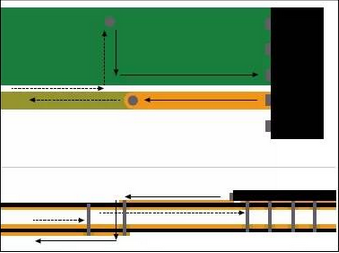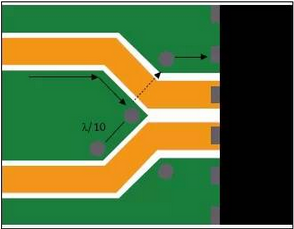RF circuit layouts need to be creative by RF engineers in order to reduce spurious signals. Keeping in mind these eight rules will not only help speed time to market, but also improve the predictability of your work schedule.
Rule 1: The ground via should be located at the ground reference switch
All current flowing through the route being routed has equal reflow. There are many coupling strategies, but the reflow typically flows through an adjacent ground plane or ground that is placed in parallel with the signal line. As the reference layer continues, all coupling is limited to the transmission line and everything is fine. However, if the signal line is switched from the top layer to the inner or bottom layer, the reflow must also obtain the path.
Figure 1 is an example. The top signal line current is immediately below the return current. When it is transferred to the bottom layer, the reflow passes through the nearby via. However, if there are no vias for reflow in the vicinity, the reflow will pass through the nearest available ground via. Farther distances create current loops that form inductors. If this unnecessary current path is offset and happens to cross another line, the interference is more severe. This current loop is actually equivalent to forming an antenna!

Figure 1: Signal current flows from the device pins through the via to the lower layer. The reflow is below the signal before being forced to flow to the nearest via to the nearest via.
Ground reference is the best strategy, but high speed lines can sometimes be placed on the internal layer. It is very difficult to place the ground reference layer up and down. Semiconductor manufacturers may be pin-limited and place the power line next to the high-speed line. If the reference current needs to be switched between layers or networks that are not DC-coupled, the decoupling capacitor should be placed next to the switch point.
Rule 2: Connect the device pads to the top ground
Many devices use a thermal ground pad on the bottom of the device package. On RF devices, these are typically electrically grounded, while adjacent pad points have an array of ground vias. The device pad can be connected directly to the ground pin and connected to any copper via the top ground. If there are multiple paths, the reflow will be split according to the path impedance ratio. The ground connection through the pad is shorter and the impedance is lower relative to the pin ground.
A good electrical connection between the board and the device pads is critical. Unpacked vias in the via array of the board may also draw away solder paste from the device during assembly, leaving a void. Filling the through holes is a good way to ensure that the welds are in place. In the evaluation, the solder mask layer was also opened to confirm that no solder mask was on the board ground below the device because the solder mask might raise the device or cause it to sway.
Rule 3: No reference layer gap
Through holes are everywhere around the device. The power network is decoupled and then decoupled and then dropped to the power plane. Typically, multiple vias are provided to minimize inductance and increase current carrying capacity while the control bus can be reduced to the inner layer. All of these decompositions are eventually completely clamped near the device.
Each of these vias creates a forbidden region on the inner ground plane that is larger than the via diameter itself, providing a manufacturing void. These forbidden zones can easily cause interruptions in the return path. Some vias are close to each other to form a ground plane trench, and the top CAD view is invisible, which further complicates the situation. The ground plane voids of the two power plane vias of FIG. 2 can create overlapping forbidden regions and cause an interruption in the return path. Reflow can only bypass the grounding layer forbidden zone, forming a common emission sensing path problem.

Figure 2: The forbidden areas of the ground plane around the via may overlap, forcing the return to drift away from the signal path. Even if there is no overlap, the forbidden zone will form a rat bite impedance interruption at the ground plane.
Even "friendly" ground vias will bring the minimum size required for board manufacturing processes to the associated metal pads. If the through hole is very close to the signal line, it will have the same erosion as if the top grounded space was bitten by the mouse. Figure 2 is a schematic view of a rat bite.
Since the forbidden area is automatically generated by the CAD software and the through hole is used frequently on the system board, there are almost always some return path interruption problems in the initial layout process. Track each high-speed line during layout evaluation and check the relevant reflow layer to avoid interruption. It is a good idea to have all vias that can create ground plane interference in any area closer to the top ground gap.
Rule 4: Maintain differentiality of differential lines
The return path is critical to signal line performance and should be considered part of the signal path. At the same time, differential pairs are usually not tightly coupled and reflow may flow through adjacent layers. Both reflows must be routed through equal electrical paths.
Even if the two lines of the differential pair are not tightly coupled, the adjacent and shared design constraints will cause the reflow to be at the same level. To really keep the parasitic signal low, a better match is needed. Any planned structure, such as a current interrupter under the differential component, should be symmetrical. Similarly, a length match may also create a waveform curve problem in the signal line. Reflow does not cause waveform problems. The length matching of a differential line should be reflected in other differential lines.
Rule 5: No clock or control line near the RF signal line
Clocks and control lines can sometimes be seen as neighbors that have no effect because they work at low speeds, even close to DC. However, its switching characteristics are almost square waves, producing unique tones at odd harmonic frequencies. Although the basic frequency of square wave emission energy will not have any effect, its sharp edge may have an impact. In digital system design, the corner frequency estimates the highest frequency harmonic that must be considered, calculated as: Fknee = 0.5 / Tr, where Tr is the rise time. Note that it is the rise time, not the signal frequency. However, square waves with sharp edges also have strong high-order odd harmonics that may only drop at the wrong frequency and couple to the RF line, violating strict transmission mask requirements.
The clock and control lines should be isolated from the RF signal line by an internal ground plane or a ground pour. If grounded isolation signals are not available, the wiring should be ensured at right angles. Because the flux lines emitted by the clock or control line form a radiating cylindrical contour around the currents that interfere with the source line, they will not generate current in the receiver line. Slowing the rise time not only reduces the corner frequency, but also helps reduce interference from the source of interference, but the clock or control line can also act as a receiver line. The receiver line can still act as a conduit for introducing parasitic signals into the device.
Rule 6: Using grounded isolated high speed lines
Most of the microstrip and strip lines are coupled to adjacent ground planes. Some flux lines are still distributed in the horizontal direction and are terminated to adjacent traces. The tone on a high-speed line or differential pair terminates on the next trace, but the grounded perfusion on the signal layer introduces a lower impedance end point to the flux line, leaving adjacent traces undisturbed.
Clusters of traces routed by the clock distribution or synthesizer device to carry the same frequency may be adjacent because the interference source tones are already present on the receiver line. However, the grouped lines will eventually be scattered. When dispersing, a grounded perfusion should be provided between the dispersing lines and a through hole should be poured into the place where it begins to disperse in order to sense the return flow back along the nominal return path. In Figure 3, the vias at the end of the ground island allow the induced current to flow to the reference layer. Do not allow more than one tenth of the wavelength between the other vias on the grounded perfusion to ensure that the ground does not become a resonant structure.

Figure 3: The top ground via of the differential line dispersion provides a flow path for the reflow.
Rule 7: Do not route RF lines on a noisy power plane
The tone enters the power plane and spreads to every place. If the spurious tones enter the power supply, buffer, mixer, attenuator, and oscillator, the interference frequency is modulated. Similarly, when the power supply reaches the board, it has not been completely emptied to drive the RF circuitry. The exposure of the RF line to the power plane should be minimized, especially for unfiltered power planes.
A large power plane adjacent to ground creates high quality embedded capacitors that attenuate spurious signals and is used in digital communication systems with certain RF systems. Another approach is to use a minimized power plane, sometimes more like a fat trace than a layer, so that the RF line is easier to completely avoid the power plane. Both of these methods work, but you can't put together the worst-case features of the two, that is, using both a small power plane and an RF line at the top.
Rule 8: Let decoupling close to the device
Decoupling not only helps to prevent stray noise from entering the device, it also helps to eliminate the tones generated inside the device and prevent it from coupling to the power plane. The closer the decoupling capacitor is to the working circuit, the higher the efficiency. Local decoupling is less subject to parasitic impedance interference from the board traces, and shorter traces support smaller antennas, reducing unwanted tone emissions. Capacitor placement is combined with the highest self-resonant frequency, usually the minimum, the smallest case size, the closest device, and the larger the capacitor, the further away from the device. At RF frequencies, the capacitors on the back of the board create parasitic inductances in the path through which the vias are connected, losing a lot of noise attenuation.
to sum up
Through board layout evaluation, we can find structures that can transmit or receive spurious RF tones. To track each line, consciously clarify its return path to ensure it is parallel to the line, especially to thoroughly check the transition. In addition, isolate potential sources of interference from the receiver. Reducing spurious signals in accordance with some simple and intuitive rules can speed up product release and reduce commissioning costs.
Author: Pete Hanish Texas Instruments Applications Engineer
No Filtering Soybean Milk Machine
Antomatic Soybean Milk Maker,Soymilk Machine Without Residue,Soy Milk Machine ,No Filtering Soybean Milk Machine
JOYOUNG COMPANY LIMITED , https://www.globaljoyoung.com